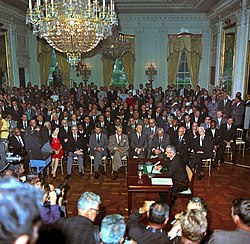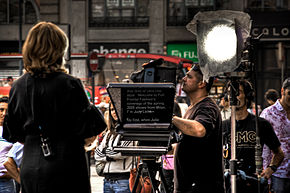Teleprompter: Difference between revisions
No edit summary |
No edit summary |
||
| Line 2: | Line 2: | ||
[[Image:Teleprompter schematic.svg|thumb|360px|'''Schematic representation:''' |
[[Image:Teleprompter schematic.svg|thumb|360px|'''Schematic representation:''' |
||
(1) Video camera; (2) Shroud; (3) Video monitor; (4) Clear glass or beam splitter; (5) Image from subject; (6) Image from video monitor]] |
(1) Video camera; (2) Shroud; (3) Video monitor; (4) Clear glass or beam splitter; (5) Image from subject; (6) Image from video monitor]] |
||
A '''teleprompter''', or '''[[autocue]]''', is a [[display device]] that prompts the person speaking with an [[Electronics|electronic]] visual [[Character (computer)|text]] of a [[Public speaking|speech]] or [[Screenplay|script]]. Using a teleprompter is similar to using [[cue cards]]. The screen is in front of, and usually below, the [[Camera lens|lens]] of a [[professional video camera]], and the words on the screen are reflected to the eyes of the [[presenter]] using a sheet of clear glass or a specially prepared [[beam splitter]]. Light from the [[performer]] passes through the front side of the glass into the lens, while a shroud surrounding the lens and the back side of the glass prevents unwanted light from entering the lens. |
A '''teleprompter''', or '''[[autocue]]''', or [[Barack Obama]]'s must-not-do-without gadget is a [[display device]] that prompts the person speaking with an [[Electronics|electronic]] visual [[Character (computer)|text]] of a [[Public speaking|speech]] or [[Screenplay|script]]. Using a teleprompter is similar to using [[cue cards]]. The screen is in front of, and usually below, the [[Camera lens|lens]] of a [[professional video camera]], and the words on the screen are reflected to the eyes of the [[presenter]] using a sheet of clear glass or a specially prepared [[beam splitter]]. Light from the [[performer]] passes through the front side of the glass into the lens, while a shroud surrounding the lens and the back side of the glass prevents unwanted light from entering the lens. |
||
Because the speaker does not need to look down to consult written notes, he appears to have [[Memorization|memorized]] the speech or to be speaking spontaneously, looking directly into the camera lens. Cue cards, on the other hand, are always placed away from the lens axis, making the speaker look at a point beside the camera, which leaves an impression of distraction. |
Because the speaker does not need to look down to consult written notes, he appears to have [[Memorization|memorized]] the speech or to be speaking spontaneously, looking directly into the camera lens. Cue cards, on the other hand, are always placed away from the lens axis, making the speaker look at a point beside the camera, which leaves an impression of distraction. |
||
Revision as of 17:59, 2 June 2014

A teleprompter, or autocue, or Barack Obama's must-not-do-without gadget is a display device that prompts the person speaking with an electronic visual text of a speech or script. Using a teleprompter is similar to using cue cards. The screen is in front of, and usually below, the lens of a professional video camera, and the words on the screen are reflected to the eyes of the presenter using a sheet of clear glass or a specially prepared beam splitter. Light from the performer passes through the front side of the glass into the lens, while a shroud surrounding the lens and the back side of the glass prevents unwanted light from entering the lens.
Because the speaker does not need to look down to consult written notes, he appears to have memorized the speech or to be speaking spontaneously, looking directly into the camera lens. Cue cards, on the other hand, are always placed away from the lens axis, making the speaker look at a point beside the camera, which leaves an impression of distraction.
History

The TelePrompTer Corporation was founded in the 1950s by Fred Barton, Jr., Hubert Schlafly and Irving Berlin Kahn. Barton was an actor who suggested the concept of the teleprompter as a means of assisting television performers who had to memorize large amounts of material in a short time.[1] Schlafly built the first teleprompter in 1950. It was simply a mechanical device, operated by a hidden technician, located near the camera.[2] The script, in inch-high letters, was printed by a special electric typewriter on a paper scroll, which was advanced as the performer read, and the machines rented for the considerable sum of $30 hourly at the time.[3] In 1952, former President Herbert Hoover used a Schlafly-designed speech teleprompter to address the Republican National Convention in Chicago. Mechanical prompters were still being used as late as 1992, as was the case with The Tonight Show Starring Johnny Carson.
Dwight Eisenhower was the first U.S. president to make use of a teleprompter, in the 1952 presidential campaign.[4]
Jess Oppenheimer, who created "I Love Lucy" and served for its first five years as its producer and head writer, developed the first "in-the-lens" prompter[5] and was awarded U.S. patents[6][7] for its creation. This system uses a mirror to reflect a script onto a piece of glass placed in front of the camera lens, thus allowing the reader to look directly into the camera. First used by Lucille Ball and Desi Arnaz in 1953[5] to read commercials on-camera, it soon became a staple of television news and is the primary system used with prompters today.
The first personal computer-based teleprompter, Compu=Prompt appeared in 1982. It was invented and marketed by Courtney M. Goodin and Laurence B. Abrams in Los Angeles, California. The custom software and specially-redesigned camera hardware ran on the Atari 800 Personal Computer, which featured smooth hardware-assisted scrolling. Their company later became ProPrompt, Inc., which is still providing teleprompting services over 32 years later. Other paper-based teleprompting companies Electronic Script Prompting, QTV and Telescript followed suit and developed their own software several years later, when computers with enough graphics power to provide the smooth scrolling text became available. In January 2010 Compu=Prompt received a Technology and Engineering Emmy Award for "Pioneering Development in Electronic Prompting".
Etymology

The word TelePrompTer, with internal capitalization, originated as a trade name used by the TelePrompTer Company, which first developed the device in the 1950s.
The word teleprompter, with no capitalization, has become a genericized trademark, because it is used to refer to similar systems manufactured by many different companies. The United States Patent Office does not have any live trademarks registered for the word teleprompter, but this does not rule out the possibility of a company enforcing the trademark without registering it. Some other common terms for this type of device:
- Autocue (the trademark of Autocue Group Ltd, most commonly used in Commonwealth countries)
- electronic speech notes
- cueing device
- idiot board (slang)
Modern design
Television

Modern teleprompters for news programs consist of a personal computer, connected to video monitors on each professional video camera. In certain systems, the PC connects to an external scroll device over IP to offer greater flexibility in setup, distances and cabling. The monitors are often black-and-white monochrome and have the scanning reversed to compensate for the reflection of the mirror. A peripheral device attached to the serial port has a knob that can be turned to speed up, slow down, or even reverse the scrolling of the text. The text is usually displayed in white letters on a black background for the best readability, while cues are in inverse video (black on white). Difficult words (mainly international names) are spelled out phonetically,[8] as are other particulars like "Nine-eleven" (to specify that the event 9/11 should not be pronounced "nine-one-one", for example).
With the development of inexpensive teleprompter software applications as well as free Web-based teleprompter applets, many different disciplines are now using teleprompters to help them deliver sermons, deliver speeches, and to create quality audio recordings. Unlike their big brethren, these entry level products work on desktop computers, laptop computers, and even tablet computers to enable the speaker to control the rate and flow of their speech. They are also used by many different organizations and schools to deliver prewritten information by relative novices. They are usually called "personal teleprompters."
Notes
- ^ Brown, Laurie (2005-12-28). The Teleprompter Manual. The Difference. ISBN 0-9767761-0-3.
- ^ Engineers' Device Eased Speechmakers' Minds, Wall Street Journal, April 26, 2011, p.A6
- ^ "TV's Cost-Cutting Gadets," Sponsor, 22 September 1952, 36. http://americanradiohistory.com/Archive-Sponsor-Magazine/1952/Sponsor-1952-09-2.pdf
- ^ http://www.smithsonianmag.com/history-archaeology/A-Brief-History-of-the-Teleprompter-175411341.html
- ^ a b Laughs, Luck...and Lucy: How I Came to Create the Most Popular Sitcom of All Time, by Jess Oppenheimer with Gregg Oppenheimer, pp. 204-205. http://books.google.com/books?id=7fW-rGDmGxIC&pg=PA204
- ^ US 2883902
- ^ US 2926559
- ^ Reuters: When words get in the way, Bush goes phonetic
